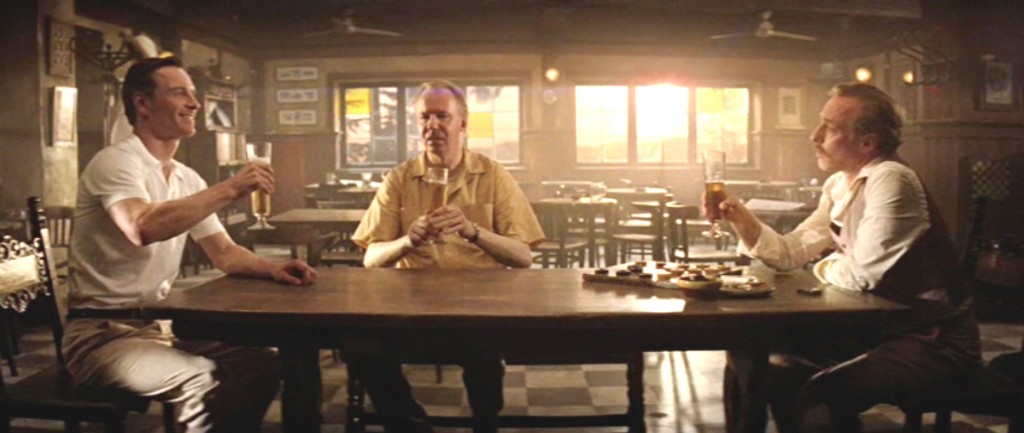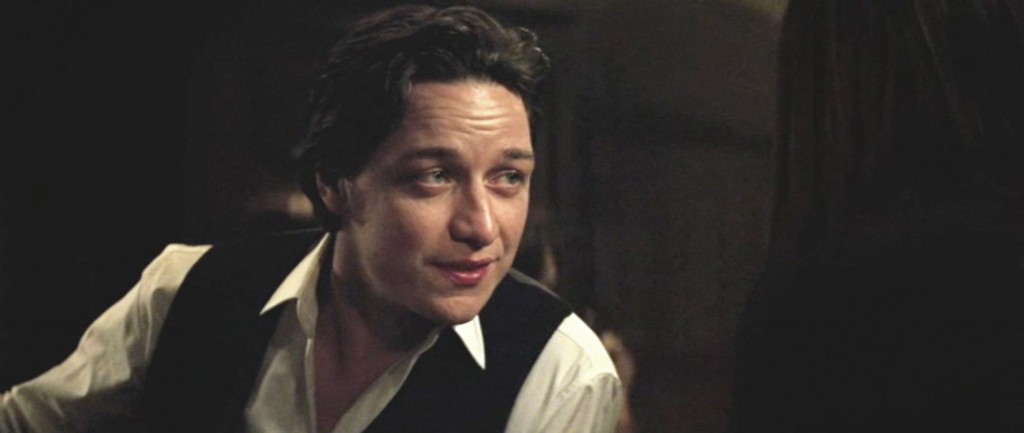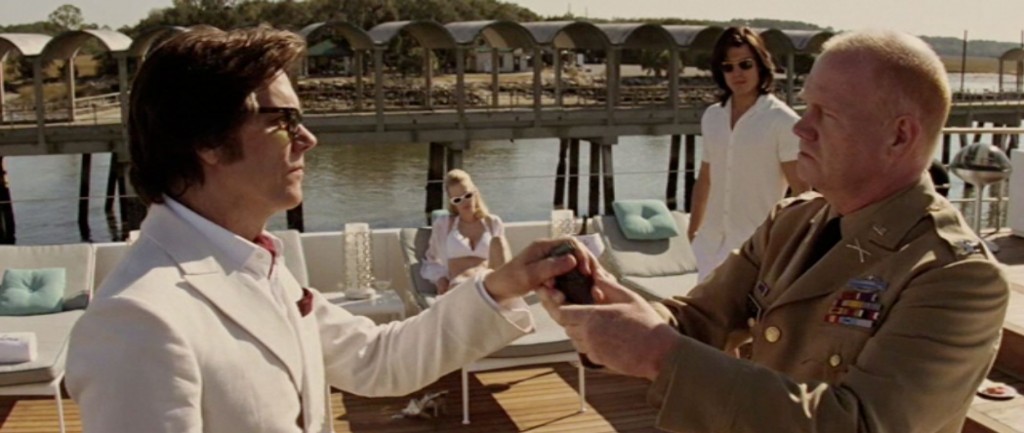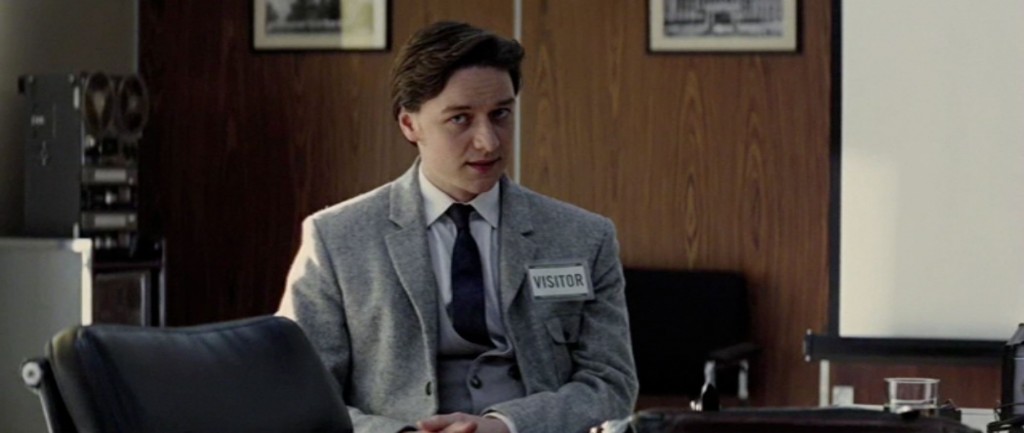X-Men: First Class part 4
Moira MacTaggert, temporarily a protagonist and looking for an expert on mutants, travels to Oxford to find Xavier, who has just received his degree. Meanwhile, Erik travels to Argentina to Find Dr. Schmidt, who he doesn’t yet know is really Sebastian Shaw. He comes to a bar that serves German beer and finds a couple of regular patrons who, as luck would have it, are pictured in a photograph up on the wall, with Schmidt, on a boat (a boat with anachronistic Trajan font on its stern). The tables have turned, Nazis are the Other now and these two pals of Schmidt are hiding in South America. Erik reveals himself and kills the two men and the German bartender. One of the men tries to defend himself with a Nazi knife (“Blood and Honor” it says on its blade) while the bartender approaches with a Luger, the Nazi pistol of choice. Even though Erik went in to get information about Schmidt, he got none from the men himself — he learned everything he needs to know from the boat photo with the anachronistic font. He kills two of the men in self-defense and one out of vengeance. Or, since he has control over all the metal objects in the room, he kills them all out of vengeance. The one with the knife gives the old Nazi excuse of “We were only following orders,” an expression that was hugely popular among escaped Nazis at the time: Adolf Eichmann had just been captured in Argentina and was tried in Jerusalem in the spring of 1962 and used the “only following orders” defense as his excuse. Eichmann had just been executed at the time this scene takes place, the knife-wielder’s use of the quote could not have been more germane, or more ill-timed to garner sympathy from Erik.
As at the top of the movie, a dramatic shift in tones as we switch from Erik and his steely, grim quest for vengeance, to Xavier, who seems to have everything. We meet him, drunk, having just given a presentation, with Raven hanging on him, obviously in love, and Moira come to learn about mutation. There’s a terrific beat where Xavier launches in on his “mutation is groovy” seduction spin and Moira cuts him off, wanting to focus on business. Before, Xavier’s expansive belief in the awesomeness of mutation was either academic or deployed toward the acquistion of sex (except in the case of Raven, who wants the sex but Charles won’t think of her that way, in spite of her being naked all the time). So, there is a man who loves mutation but only to get sex from “normal” women, not mutants, and he’s met by a sexy woman who doesn’t want sex but actually wants to talk about mutation, while Raven, a hideous mutant, glowers jealously in the corner. Xavier puts his fingers to his temple (apparently he can’t read someone’s mind without doing that) and sees Moira’s whole story, with Shaw and Emma and Riptide and Azazel and the whole schmeer. A challenge has been laid before him: move your theories out of the lecture hall and the barroom and into the real, and dangerous, world.
And look, here’s a chunk of that world now, as Shaw confabs with Col Hendry on that very boat in Miami. Miami, of course, was a key city during the Cold War, being America’s front porch to Cuba. It was the Miami mafia who, in real life, was conspiring with the CIA to kill Castro, and who, legend has it, then conspired to kill Kennedy. And here is Shaw in the middle of it with his team of mutants, with Col Hendry trying to extort money and peace of mind out of them. Shaw calls his bluff, revealing his own mutant superpower: he can absorb, hold, and release energy. That, it would seem, answers the question of “Why didn’t Erik just kill him?” and “Why hasn’t he aged?” Here, the Other have the Establishment Man cornered, on their own turf, as it were, and Shaw uses his power to kill Hendry. (What happens after that, I don’t know — certainly people will come looking for Hendry, not that they could really get to Shaw if they wanted to.)
While Shaw is killing Hendry, Xavier is at CIA headquarters at Langley to give a talk on mutation. Direcrot McCone has, apparently, given Moira another shot at proving herself. Again, I’m not sure why — operatives don’t generally get the ear of the director without a good deal more than a gut feeling — but here she is again, having brought Xavier in to back her up. McCone, for his part, lets us know where he found Moira — in the typing pool. It makes sense, but a jump from typist to operative is a huge one, even now, and I would imagine unheard of in 1962. No matter, the point of the scene is, again, in reflection of the previous, the Other and the Establishment. On Shaw’s boat, the Establishment tried to put its foot down on the Other’s turf and failed. Now, the Other has been invited into the inner sanctum of the Establishment (CIA headquarters! A meeting with the Director! And Raven, whose only qualification is “Xavier’s sister,” is there!) and, like Shaw, hands the Establishment its ass. Xavier reads everyone’s minds (including a high-ranking officer who is the father of William Stryker) and Raven shows her true colors. The Establishment reacts with horror — “They’re god-damned spies!” blurts McCone — but their horror is not of mutation but of, of course, Communism. At the back of the room is the guy who is always hanging around the corners of CIA offices, the guy who would later become the Smoking Man of the X-Files (although, in 2011, you couldn’t smoke in a movie, even one set in 1962), who sees opportunity in the weird. The Man in the Black Suit, which is what the movie calls him, is a prototype of the weird edge of 1960s intelligence, the kind of guy who would later chase after UFOs and employ men to stare at goats. First Class is stuffed to the gills with genuine history, which gives it a resonance that other superhero movies don’t.




First Class is stuffed to the gills with genuine history, which gives it a resonance that other superhero movies don’t.
But sadly, for me and many of my generation, our education in 20th century U.S. history is so deficient, I only barely recognize the references here. (My awareness pretty much ends at “there was something called the Cuban Missile Crisis.” It’s shameful.)
That’s good to know. As I’m writing this, I keep having to stop and consider — “Do I need to explicate more? Is the reader following, or the opposite, am I breezing past things that are baffling the reader? Do they know about Castro, or is that something I need to remind them about?” etc.
Ehhh…. I’m Canadian, so a lot of this isn’t my history, but my knowledge of a lot of this stuff is from and inspired by comics. All-Star Squadron leads to research on World War II and the CMC (the JLA/JSA/A*S time-travel crossover).
Castro, to me, is “the guy who will never die.” That really is 90% of what I know about him.
Cuban Missile Crisis: something involving nuclear missiles in Cuba, I think from the Soviet Union, and there was some kind of short faceoff, after which I believe the USSR backed down.
Mafia: it exists and, um, does stuff, most of which is probably not much like movie!Mafia.
I do at least know my WWII history somewhat, and the Holocaust, and the Nuremburg Trials (though I didn’t know about the timing of Eichmann’s execution). But the significance of Vegas and Miami to the history of this time period? Completely missed that until you started explaining it.
The significance of Miami, Cuba and the Mafia is all explained in The Godfather, Part II.
Which I, heretically, have not seen. 🙂
(Also, oops. Didn’t realize I’d posted my reply in the wrong place.)
The internet was invented so long ago. How could you know?
If you can stand some phoney Boston accents (and some people cannot, apparently), THIRTEEN DAYS is a pretty interesting dramatization of the Cuban Missile Crisis from the Kennedys’ POV.
In conclusion, if you want some grounding on the historical context of XMFC without the use of books or documentaries, watch Thirteen Days, Godfather Part II, and the DeNiro/Damon film The Good Shepherd. While the latter’s kind of dull at times, it is a pretty good survey of the early history of the CIA from the OSS days to about the early 70s. It takes a lot of liberties with history for the sake of drama, but the major events and controversies are covered.
In my day, there was a TV movie called The Missiles of October with William Devane as JFK and Martin Sheen as RFK, based on the book Thirteen Days. Thirteen Days, on the other hand, was not based on the book Thirteen Days, strange as that sounds.
God, I’ve been following your stuff since LiveJournal. I’m mid-20s. I followed most of the movie historically pretty well, but I was also unaware about the coinciding of the execution with his being in Argentina. However I know Nazis are in South America because of Boys From Brazil, duh.
I love how you make the Erik-Charles contrast so clear. Especially the idea that Erik is the embodiment of the embittered, stubborn realist secret agent type to foil Charles as the untouched, disconnected idealist science type. Very cool to see it so clearly detailed out. Plus Raven as a sexless sex object is a great point, meaning her complete inability to capture Charles’s attention and the teeth brushing to show her mundanity, when in past movies she’s only ever the opposite.
I never noticed before – in that first picture of Xavier in this post, he’s wearing what looks from 2013’s perspective like a Han Solo getup. Presumably to evoke a rascally / roguish-yet-heroic quality…
I really enjoyed the AVENGERS review, and this FIRST CLASS review. If encouragement means something to you, please continue. This is great.
Great work here, as always.
I don’t follow this bit though: “although, in 2011, you couldn’t smoke in a movie, even one set in 1962”. What am I missing here?
Studios have rules about smoking in movies now. If someone smokes in a movie, they have to put a thing at the end that says that they didn’t take money from tobacco companies and they don’t condone the use of tobacco products. For a PG-13 movie aimed at younger people, the studio would be really strict about that.